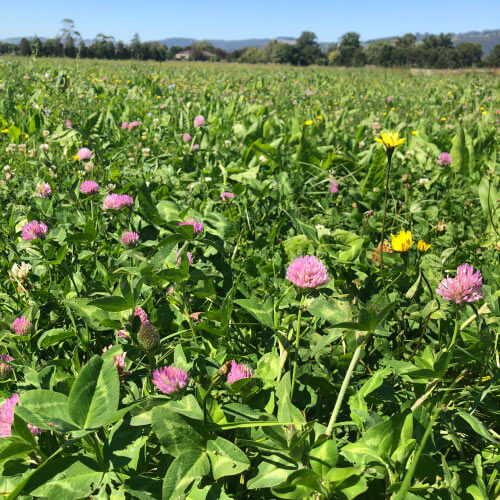Benefits of multi specie pasture swards are not a new occurrence, however there’s renewed interest in what diverse swards can offer modern production systems.
Well-designed multi species pastures will have a diversity that can increase overall yield, diet composition and reduces the risks of a range of environmental challenges. On the flip side there are things to be aware of when grazing alternative crops such as optimising establishment, limited weed control and animal health issues such as high levels of nitrate in brassicas.
Peter Notman, dairy farmer and forage specialist at Notman Pasture Seeds in Poowong says some producers add different varieties of seed to their standard winter and summer pasture stands to provide more forage diversity and drought hardiness.
“For example, the producer might be planning a silage/hay crop with annual ryegrasses and/or forage oats, but also plant clover, grazing turnips such as Marco, herbs such as Oracle plantain and Chico chicory to provide further green feed for grazing after the silage has been harvested”
Since the development from a beef operation to an intensive dairy operation in 2008, multi specie blends have been used quite extensively and successfully for their herd.
“We are continuing to learn more on the interactions of different species, what works and what doesn’t work, and carrying this knowledge to our farmer clients with the seed business.”
“At the dairy, for our spring plantings we aim to plant achieve a good balance of fibre and protein with the likes of millet, forage rape, leafy turnip, chicory, plantain and legumes”
“Multi specie blends like these give us more feed than traditional ryegrasses, reliability/flexibility in drier conditions and probably most importantly our animals milking well off it”
“Some of the locals, namely beef producers, have marvelled at the amount of feed we have as they drive past, with the cultivars planted having had tremendous resilience to drier conditions and after each rain event their re-growth has been quite amazing”
Understanding the right composition can be complex as every farm and paddock is different, so Notman Pasture Seeds have carefully designed multi specie blends for dairy farmers who are looking for an alternative to standard ryegrass and legume pasture blends.
“These blends generally produce good quality forage year round, with a range of different root systems, includes, legume species, different flowering plants and species that will add organic matter to the soil surface and in the soil as root mass”
“Certain species of multi specie blends are highly competitive with other species, so we have suggested sowing rates to ensure that all species are well-represented in the pasture blends.”
Mr Notman said to start on small areas and work out which varieties prosper on your property. Observe the results and then adjust the species and seeding rates as necessary.
“You’ll see different plants prosper at different times of the year. This plant diversity provides for a more balanced diet of protein, fibre, energy, and minerals, and these complex mixes seem to have an extra benefit for the soil.”
- Spring/summer forage planting options include – millet, forage sorghum, forage rape, kale, turnip, leafy turnips, chicory, herbs, clovers, lucerne, maize
- Winter/spring forage planting options include – annual ryegrass, italian ryegrass, fescue, cocksfoot, legumes, winter brassicas, cereals
Get in touch with the Notman Pasture Seeds team on (03) 5659 2314.







